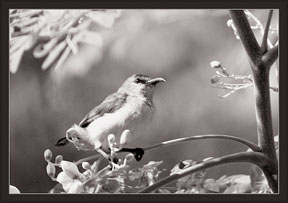Count not to kill, but to preserve
December - FOGSL’s bird count month:
By Uditha WIJESENA
Archeological evidence shows that humans have been in the habit of
counting for at least 50,000 years or more. This has been primarily to
keep track of their livestock and economic data of farm produce, debts
etc.

In modern times counting is a priority in almost all sciences and is
the basis for the statistical sciences.
Species counts are a primary source of data in the science of
Conservation Biology.
And studying birds for conservation purposes require regular counts
as they seem to be found in different locations at different times.
Change in climate brings about inborn instincts for migration in the
animal kingdom.
And bird species the “class aves” in the animal kingdom are the
largest single form to migrate regularly. Furthermore birds are now
considered as an ideal indicator species to predict macro to micro
environmental changes that we humans tend to realize quite late.
A common example would be the increase in the raven (crow) population
with relation to garbage. No garbage no crows? The disappearance and
return of common birds in the European climates have developed various
cultures and myths in these societies.
Two Little Black Birds and the mythical predictions on the number of
magpies seen go as;
One for sorrow
Two for joy
Three for a wedding
Four for a birth
Five for silver
Six for gold
Seven of a secret not to be told
Eight for heaven
Nine for hell
And ten for the devil’s own self.
These and many more fables related to birds have passed on to
generations as means of counting practice to children.
The Christmas Bird Count famous in the USA is the forerunner in the
recent history of counting birds.

The North Americans up to about the beginning of the 19th century
participated in a tradition called a Christmas “side hunt”.
The hunt was to account for how many birds you could kill. The
killings had no reason and did not matter if the bird were beneficial,
non-beneficial, beautiful or rare.
At the turn of the 19th century the US ornithologist Frank Chapman;
later a member of the Audubon Society proposed counting birds on
Christmas rather than killing them. From there on the Christmas Bird
Count was to stay with the Audubon Society as an annual event which
later became an immense contributor the study of the American birds.
Ornithology, the scientific study of birds is highly dependent on
counts and censuses. This is by no means an easy task as birds are found
almost in all environments and their ability to move by flying does not
restrict them from geographical, political and manmade barriers.
Bird populations are very dynamic and fluctuate constantly. No single
scientist or a study team could document this complex distribution and
movement of so many species in a short time. Thus knowing where the
birds are present will make the scientist and the bird enthusiast learn
a lot about them.
To overcome this complex situation the scientists studying birds the
world over depends very much on the community. Your help is needed to
document the representation of birds from your community, be it just
five birds in your back yard to over 75 species that you may see on a
trip to a National Park.
As the Audubon in the USA, Sri Lanka too has the Field Ornithology
Group of Sri Lanka (FOGSL) in the University of Colombo, a scientific
body and the affiliate to the Bird Life International working towards
the protection and the well being of the birds in Sri Lanka.
Founded in the year 1976 the FOGSL has come a long way in the
conservation of birds in Sri Lanka and has been a party to world bird
counts in the country, and in identifying important bird areas in the
country. FOGSL from the year 2005 has been conducting its own Bird Count
Month in the month of December. The month of December has significance
to Sri Lanka as being the mid month of the bird migratory period from
September to April. It is thought that the migrants are distributed
throughout the country by December and thus the best time to count.
Members, non members and volunteers who have a knack for birds are
hereby requested to look out and record the birds that you see during
the month of December and list them with dates and place names which
would then be fed into a world data base maintained in the University.
Your small contribution today will be of immense value tomorrow in
planning the future. Take time to record the birds while on your trips
out of Colombo during the festive season; for we never had a crow on the
Horton Plains 25 years ago where now are a plenty. The only reason is
that you did not bring back the garbage you took up there. The house
sparrow that nested in the old earthen pot is no more with the amount of
chemical used in our rice paddy fields. It was too late when we found
out. So help save the surviving species. Sri Lanka is still rich in its
bird life and let us keep it same for the generations to come.
Let us keep the bird an environmental indicator? Please send your
records in the preferred language to the “Compiler December Bird Count”,
Field Ornithology Group of Sri Lanka, Department of Zoology, University
of Colombo, Colombo 3.
Those who have access to the internet could key in your records at
http:worldbirds.org/srilanka www.worldbirds.org/srilanka and be regular
contributors to a worthy cause.
|
